
HOME
INTRO
SYMBOLS
ALMANAC
ECONOMY
GEOGRAPHY
STATE MAPS
PEOPLE
FORUM
NEWS
COOL SCHOOLS
STATE QUIZ
STATE LINKS
BOOK STORE
MARKETPLACE
GUESTBOOK
CONTACT US


You may double left-click on a word on this page to retrieve its definition. Tweet Follow
Texas State Tree
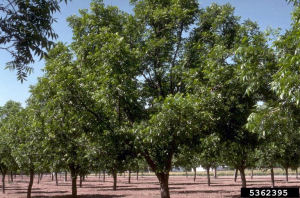
Texas State Tree: Pecan Tree
Howard F. Schwartz, Colorado State University, Bugwood.org
Chapter 79 of the 36th Legislature, Regular Session named the pecan tree as the official state tree of thee State of Texas.
The pecan tree was adopted as the official state tree of Texas when Governor William Pettus Hobby signed Senate Bill No. 317 on March 20, 1919.
The choice of the pecan tree as the official State tree of Texas was said to have been influenced by popular former Governor James Hogg's love of the pecan tree and his request to have one planted at his grave site.
According to the Texas Historical Society the pecan tree is one of the most widely distributed trees in the state and is native to 150 counties. In addition, it is grown commercially in another 30 counties.
NAMING THE PECAN AS THE TEXAS STATE TREE.
[S. B. No. 317.]CHAPTER 97.
An Act naming the Pecan as the Texas State tree and declaring an emergency.
Be it enacted by the Legislature of the State of Texas:
SECTION 1. That the Pecan Tree be, and the same is hereby named and constituted the State Tree of Texas.
SEC. 2. The fact of the near approach of the end of the Session and the importance of this legislation, and the crowded condition of the calendar, creates an emergency and imperative public necessity requiring the suspension of the Constitutional rule that bills be read on three several days, and that this act take effect and be in force from and after its passage, and it is so enacted.
[NOTE.--S. B. No. 317 passed the Senate on March 14, 1919, by a viva voce vote; and passed the House of Representatives on March 18, 1919, by a viva voce vote.]
Approved March 20, 1919.
Becomes effective 90 days after adjournment.
Texas has named more official state symbols than any other state. The pecan tree was designated the official state tree of Texas when Senate Bill No. 317 was chaptered, Chapter 97, by the Texas Legislature. It is one of a very short list of symbols that are recorded in the Texas Statutes. Other members of this elite group include the state flag, the state seal, the state song, the state bird, the state flower, the state plays, and the official Texas Tejano Music Hall of Fame. All other symbols were designated by concurrent resolution and were not chaptered and recorded in the Texas Statutes.
Texas Law
The following information was excerpted from the Texas Statutes: Government Code, Title 11, Subtitle A, Chapter 3101, Section 3101.009.
TITLE 11. STATE SYMBOLS AND HONORS; PRESERVATION
SUBTITLE A. STATE SYMBOLS AND HONORS
CHAPTER 3101. STATE SYMBOLS
Sec. 3101.009. STATE TREE.
Sec. 3101.009. STATE TREE. The state tree is the pecan tree.
Added by Acts 2001, 77th Leg., ch. 1420, Sec. 7.001, eff. Sept. 1, 2001.
Sources...
Claudia Hazlewood, "STATE TREE," Handbook of Texas Online , accessed March 27, 2013. Published by the Texas State Historical Association.
"Sec. 3101.009. STATE TREE." Texas Statutes. State of Texas, n.d. Web. 23 Mar. 2013.
Senate Bill No. 317. Digital image. Texas State Legislature, 1919. Email. 27 Mar. 2013.
Shankle, George Earlie. State Names, Flags, Seals, Songs, Birds, Flowers, and Other Symbols. Irvine, Calif.: Reprint Services Corp, Revised edition, 1971.
Shearer, Benjamin F. and Barbara S. State Names, Seals, Flags and Symbols: A Historical Guide Third Edition, Revised and Expanded. Westport, Conn: Greenwood Press, 3 Sub edition, 2001.
"Texas Constitution and Statutes." Legislative Reference Library of Texas. The Legislature of the State of Texas, 2011. Web. 27 Sep 2011. .
Additional Information
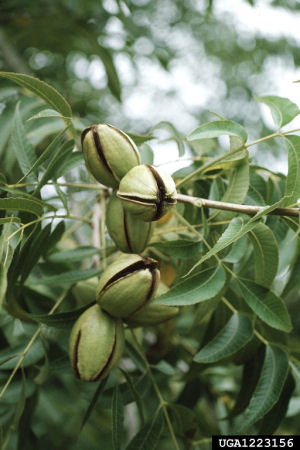
Pecan Tree Fruit (Nuts)
Jerry A. Payne, USDA Agricultural Research Service, Bugwood.org
The Texas State Tree: Pecan: Lonestar Junction. Texas history resource provided for the benefit of both Texans and "foreigners" alike.
State Tree: Texas State Historical Association: The Handbook of Texas Online.
Carya illinoinensis ( Pecan ): Plant Encyclopedia from MyGardenGuide.
Carya illinoinensis (Wangenh.) K. Koch Pecan: United States Department of Agriculture, Forest Service. Agriculture Handbook 654: Silvics of North America, Volume 2.
Carya illinoinensis (Wangenh.) K. Koch pecan: USDA, NRCS. 2013. The PLANTS Database (http://plants.usda.gov, 27 March 2013). National Plant Data Team, Greensboro, NC 27401-4901 USA.
pecan Carya illinoinensis (Wangenh.) K. Koch: Tree Identification Fact Sheet from the Virginia Tech.
Carya illinoinensis (Wangenh.) K. Koch: Integrated Taxonomic Information System (ITIS) Here you will find authoritative taxonomic information on plants, animals, fungi, and microbes of North America and the world.
State trees: Complete list of official state trees from NETSTATE.COM
More symbols & emblems: Complete list of official Texas state symbols from NETSTATE.COM.
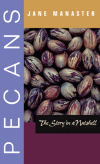
Pecans
Jane Manaster
Pecans: The Story in a Nutshell, by Jane Manaster. 120 pages. Publisher: Texas Tech University Press (January 15, 2008)
Jane Manaster?s Pecans, updated from its original 1994 publication, explores the natural history, cultivation, and uses of the pecan tree and nut. Her engaging account pieces together a fascinating mosaic of the peoples caught up in the pecan story?Native Americans, Spanish explorers, European immigrants and their American descendants, African Americans, and Mexican Americans.
Manaster also describes the life cycle of the pecan tree, the development of many cultivated species, and predators and diseases of the pecan. She chronicles the successes of commercial growers in extending the pecan?s original range eastward from the Mississippi basin to Florida and westward to California; and she charts the growth of the commercial pecan industry, especially in Georgia, Texas, New Mexico, and Arizona.
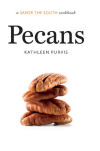
Pecans
Kathleen Purvis
Pecans: A Savor the South Cookbook, by Kathleen Purvis. 104 pages. Publisher: The University of North Carolina Press (September 10, 2012)
"Show me a recipe with pecans, and I have to try it." Attributing her own love of this American nut to the state of her birth--Georgia is the nation's leader in growing pecans--and to the happy fact that her mother "hardly made a cookie, candy, or pan of Sunday dressing without them," Kathleen Purvis teaches readers how to find, store, cook, and completely enjoy this southern delicacy. Pecans includes fifty-two recipes, ranging from traditional to inventive, from uniquely southern to distinctly international, including Bourbon-Orange Pecans, Buttermilk-Pecan Chicken, Pecan Pralines, and Leche Quemada.
In addition to the recipes, Purvis delights readers with the pecan's culinary history and its intimate connections with southern culture and foodways. Headnotes for the recipes offer humorous personal stories as well as preparation tips such as how to choose accompanying cheeses.
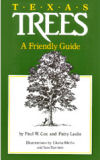
Texas Trees
Texas Trees: A Friendly Guide, by Paul W. Cox and Patty Leslie. 374 pages. Publisher: Corona Pub Co; New edition (August 1988)
San Antonio botanist Paul Cox and horticulturist Patty Leslie explore 120 trees from among 46 Texas species in a way that even the layman can appreciate. Learn about everything from history, legends and folk medicine to the commercial uses of Texas trees.
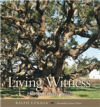
Living Witness
Ralph Yznaga
Living Witness: Historic Trees of Texas, by Ralph Yznaga. 164 pages. Publisher: Texas A&M University Press (April 3, 2012)
In a beautiful tribute to the natural heritage of the Lone Star State, photographer Ralph Yznaga celebrates the strong connections between Texans and their trees. Inspired by the old Texas Forest Service book, Famous Trees of Texas, Yznaga has captured the continuing attachment we have to these magnificent reminders of our culture and history. Stunning images, stories, a detailed map, and driving directions to thirty-seven famous (and infamous) trees help us appreciate how entwined the lives of people and trees are.
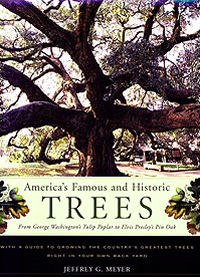
America's Famous and Historic Trees
by Jeffrey G. Meyer
America's Famous and Historic Trees: From George Washington's Tulip Poplar to Elvis Presley's Pin Oak (Hardcover)
by Jeffrey G. Meyer. 130 pages. Houghton Mifflin Harcourt; First Edition (April 20, 2001)
America's Famous and Historic Trees tells the stories of various trees that Meyer and his cohorts rescued or propagated: oftentimes, when trees were going to be cut down, he and his workers headed off the bulldozers, rescuing the tree with their massive tree hoe. Other trees--like the Indian Marker Pecan in southeast Dallas--were propagated before they died.
Trees : National Champions (Hardcover)
by Barbara Bosworth. Bosworth captures the ineffable grace and dignity of trees with clarity and directness: the green ash that shades a Midwestern crossroads, the common pear that blooms in a Washington field, and the Florida strangler fig with its mass of entwining aerial roots. Her black and white photographs, panoramic views taken with an 8 x 10 camera, show the immensity of the largest species and the hidden triumphs of the smallest

